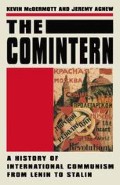Abstract
For the fifty-one men and women who gathered in Moscow in March 1919 to found the Communist International, world proletarian revolution was no utopian day-dream. Capitalism, if not certified dead and buried, was in its final death throes. Lenin and the Bolsheviks had premised their seizure of power in October 1917 on the inseparability of the Russian and international revolutions. Russia constituted the weakest link in the imperialist chain and the example of Soviet democracy would act as the spark for socialist revolution throughout Europe and subsequently the entire world. With socialism triumphant in the advanced industrialised countries, the survival of the beleaguered Soviet regime would be guaranteed. The Bolsheviks’ cast-iron belief in the inevitability of worldwide revolution sprang from two equally important sources. First, Marxist theory provided the ‘scientific’ prognosis of the collapse of capitalism, an exhausted economic system that generated mass poverty, imperialist conflict and war. Secondly, theory was being borne out by reality. Developments in the European heartland in 1918 appeared to confirm the imminence of revolutionary upheaval.
Preview
Unable to display preview. Download preview PDF.
Notes
R. Service, Lenin: A Political Life, vol. 1 (Basingstoke, 1985) p. 8.
Cited in I. Deutscher, The Prophet Armed. Trotsky: 1879–1921 (Oxford, 1954) p. 90.
M. Waller, Democratic Centralism: An Historical Commentay (Manchester, 1981) pp. 21–30.
The following two paragraphs are based on N. Harding, Lenin’s Political Thought, vol. 2 (London, 1981) pp. 16–70.
Cited in R. C. Nation, War on War: Lenin, the Zimmerwald Left, and the Origins of Communist Internationalism (Durham and London, 1989) p. 78.
For an iconoclastic interpretation of the impact of Kautsky’s Marxism on Lenin, see M. Donald, Marxism and Revolution: Karl Kautsky and the Russian Marxists 1900–1924 (New Haven and London, 1993).
R. K. Debo, Revolution and Survival: The Foreign Policy of Soviet Russia 1917–18 (Liverpool, 1979) p. 420.
E. H. Carr, The Bolshevik Revolution 1917–1923, vol. 3 (Harmondsworth, 1966) pp. 67, 68.
B. Lazitch and M. M. Drachkovitch, Lenin and the Comintern, vol. 1 (Stanford, 1972) pp. 32–3, 43–4.
J. D. White, ‘National Communism and World Revolution: The Political Consequences of German Military Withdrawal from the Baltic Area in 1918–19’, Europe—Asia Studies, vol. 46 (1994) pp. 1349–69.
Cited in J. Riddell (ed.), Founding the Communist International. Proceedings and Documents of the First Congress: March 1919 (New York, 1987) pp. 19, 20.
I. Deutscher, ‘Record of a Discussion with Heinrich Brandler’, New Left Review, no. 105 (September—October 1977) p. 49.
J. Riddell (ed.), Workers of the World and Oppressed Peoples, Unite! Proceedings and Documents of the Second Congress, 1920, vol. 2 (New York, 1991) pp. 765–71.
A. S. Lindemann, The ‘Red Years’: European Socialism versus Bolshevism,1919–1921 (Berkeley, 1974) pp. 174–216.
For the troubled relationship between the Communist Youth International and the Comintern, see R. Cornell, Revolutionary Vanguard: The Early Years of the Communist Youth International,1914–1924 (Toronto, 1982).
D. Geary, European Labour Protest 1848–1939 (London, 1984) pp. 149–55.
D. Geary, European Labour Politics from 1900 to the Depression (Basingstoke, 1991) pp. 59–64.
F. Beckett, Enemy Within: The Rise and Fall of the British Communist Party (London, 1995) p. 12.
B. Lazitch, ‘La formation de la section des liaisons internationales du Komintern (OMS) 1921–1923’, Communisme, no. 4 (1983) pp. 65–80;
N. E. Rosenfeldt, Stalin’s Secret Chancellery and the Comintern (Copenhagen, 1991).
Cited by F. I. Firsov, ‘Komintern: mekhanizm funktsionirovaniia’, Novaia i noveishaia istoriia, no. 2 (1991) p. 36.
F. Firsov, ‘Partiia i Komintern’, Kommunist, no. 7 (1991) p. 93.
See A. A. Galkin’s contribution to the roundtable discussion, ‘Nekotorye voprosy istorii Kominterna’, Novaia i noveishaia istoriia, no. 2 (1989) p. 83.
E. H. Carr, The Interregnum,1923–1924 (Harmondsworth, 1969) p. 222.
J. Degras, ‘United Front Tactics in the Comintern 1921–1928’, in D. Footman (ed.), International Communism (London, 1960) p. 9.
A. D’Agostino, Soviet Succession Struggles: Kremlinology and the Russian Question from Lenin to Gorbachev (London, 1989) p. 49.
A. Iu. Vatlin, Komintern: pervye desiat let (Moscow, 1993) pp. 49–50.
G. Swain, ‘Was the Profintern Really Necessary?’, European History Quarterly, vol. 17 (1987) pp. 57–77.
K. McDermott, The Czech Red Unions,1918–1929: A Study of their Relations with the Communist Party and the Moscow Internationals (Boulder/New York, 1988);
R. Wohl, French Communism in the Making,1914–1924 (Stanford, 1966).
For details, see W. T. Angress, The Stillborn Revolution: The Communist Bid for Power in Germany,1921–1923 (Princeton, 1963) pp. 332–50.
Copyright information
© 1996 Kevin McDermott and Jeremy Agnew
About this chapter
Cite this chapter
McDermott, K., Agnew, J. (1996). Comintern in the Era of Lenin, 1919–23. In: The Comintern. Palgrave, London. https://doi.org/10.1007/978-1-349-25024-0_1
Download citation
DOI: https://doi.org/10.1007/978-1-349-25024-0_1
Publisher Name: Palgrave, London
Print ISBN: 978-0-333-55284-1
Online ISBN: 978-1-349-25024-0
eBook Packages: Palgrave History CollectionHistory (R0)

